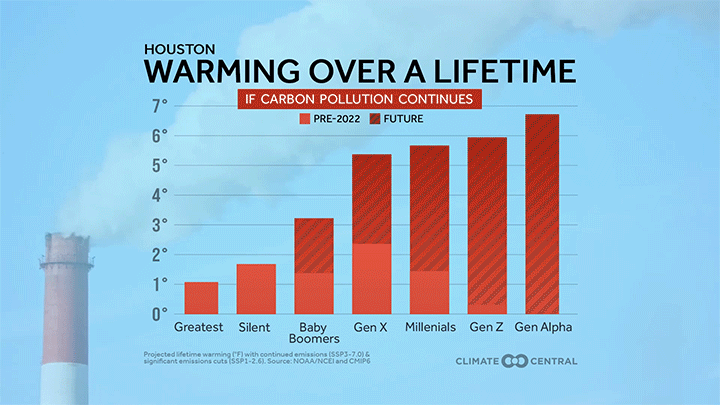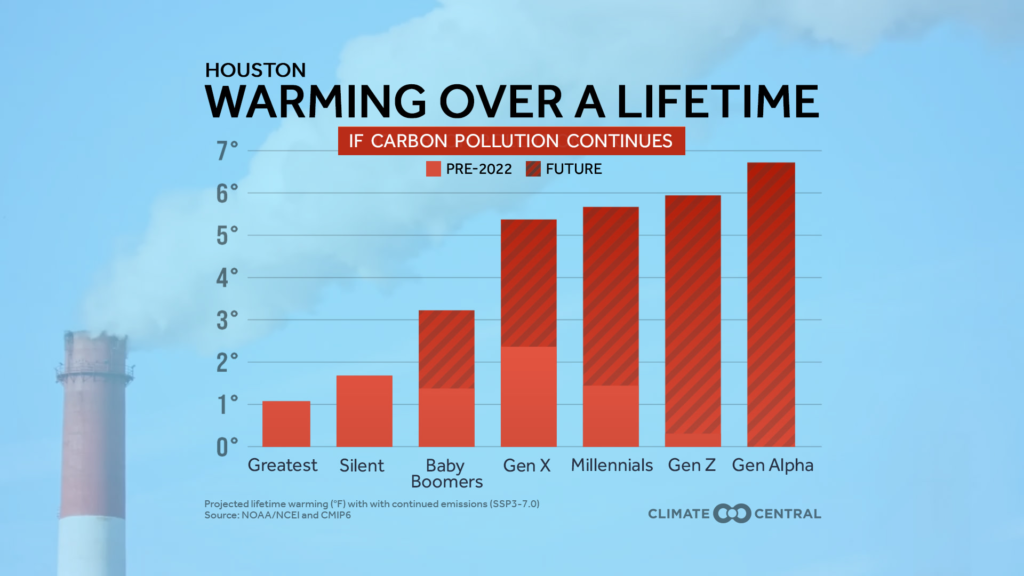The main purpose of this ongoing blog will be to track global extreme or record temperatures related to climate change. Any reports I see of ETs will be listed below the main topic of the day. I’ll refer to extreme or record temperatures as ETs (not extraterrestrials).😉
Main Topic: Warming Across Generations
Dear Diary. If you knew your grandad or even at this point your great grandad, did you ever hear a story of them having to walk a few miles in the snow go get to school? This is often a tale we are told that older generations have said to kids. I’m old enough now to be a grandad, and I can tell the tale of how it got so cold in Atlanta during the winter of 1976/77 that Dekalb County ran so low on natural gas that schools closed for a week as temperatures frequently dipped towards 0°F. This decade around Atlanta it rarely gets bellow 20°F, although it briefly did in December 2022.
In the past global warming after the turn of the 20th century was so slow that it was hardly noticed over one lifetime. Now warming is starting to happen so fast that all generations from the 21st century will notice stark changes as they mature. Climate Central has posted more information on generational warming which I am sharing today:
Warming Across Generations | Climate Central

KEY CONCEPTS
- March 23 is World Meteorological Day, marking the date in 1950 when the World Meteorological Organization was established.
- New Climate Central analysis explores the theme of this year’s World Meteorological Day, The Future of Weather, Climate and Water across Generations.
- Using the latest climate models, this analysis looks at how much warming younger generations could experience during their lifetimes if carbon pollution either continues or is cut rapidly.
- With high continued emissions, Millennials and Gen Z across 242 U.S. locations would experience 1.8x to 2x more lifetime warming, respectively, than Baby Boomers.
- But rapid near-term cuts in carbon pollution could set younger generations on a different path—toward a future with less warming and fewer risky extreme events.
Since 1950, our planet has experienced rapid warming, ocean acidification, more extreme weather, melting glaciers and sea ice, and rising sea levels due to carbon pollution.
Climate change continues to affect lives across the U.S. and around the globe—through more frequent billion-dollar disasters, rising health risks, and daily temperatures boosted by carbon pollution, among other impacts.
Today’s climate impacts reflect at least 1.1°C (2.0°F) of global warming. These impacts worsen with every bit of additional heat-trapping carbon pollution—which is why nearly 200 countries have agreed to keep global warming well below 2°C (3.6°F) with an aspirational limit of 1.5°C (2.7°F).

Click the downloadable graphic: Local Warming Across Generations with Continued Emissions
The Future of Weather, Climate, and Water across Generations
With continued carbon pollution, future generations are likely to face accelerating change and intensifying risks.
According to a 2021 study, even if current global climate policy pledges are met, people born in 2020 would experience between 2x and 7x more extreme events—especially heat waves—over their lifetimes than people born in 1960.
These differences across generations are reflected in the theme of this year’s World Meteorological Day: The Future of Weather, Climate and Water across Generations. Climate Central explored this theme using the latest climate models to assess current and future warming experienced across generations.

Click the downloadable graphic: Local Warming Across Generations with Emissions Cuts
Global decisions today, local warming for decades
A recent Climate Central analysis used the latest generation of climate models and different greenhouse gas emission scenarios to compare two futures: a world with continued high emissions (SSP3-7.0), and a world with aggressive emissions cuts (SSP1-2.6) that stay within the Paris Agreement limits of 2°C of global warming this century.
- In a scenario with rapid emissions cuts (SSP1-2.6), projected warming across the U.S. ranges from 1°C to 2.5°C (1.8 to 4.5°F) relative to the 1991–2020 baseline by 2050 before stabilizing through 2100.
- In a scenario where emissions are very high (SSP3-7.0), projected warming ranges from 3°C to 5°C (5.4 to 9°F) by 2100.
- All 246 U.S. locations analyzed warm under both emissions scenarios, with the strongest warming in the Midwest and parts of New England.

Click the downloadable graphic: Past Warming Across Generations
Warming across generations
Climate Central extended this analysis to assess the lifetime warming (using a representative 80-year period) experienced across seven generations, depending on how quickly global heat-trapping emissions are cut.
The analysis focuses on the lifetime warming experienced by the following generations in 242 U.S. locations: Greatest (born 1913–1927), Silent (born 1928–1942), Baby Boomers (born 1948–1962), Gen X (born 1965–1979), Millennials (born 1981–1995), Gen Z (born 1998–2012), and Gen Alpha (born 2013–2022).
With continued emissions: Younger generations (Millennials, Gen Z, and Gen Alpha) could experience between 6 to 7°F of warming over their lifetimes in a scenario with high continued emissions (SSP3-7.0). By comparison, the Greatest, Silent, and Baby Boomer generations would experience 1.3 to 3.4 °F of warming over the course of their lifetimes.
- In other words, with very high continued emissions (SSP3-7.0), Millennials and Gen Z would experience 1.8x to 2x more warming over their lifetimes, respectively, than Baby Boomers.
With rapid cuts: If we manage to keep global warming under 2°C with rapid emissions cuts (SSP1-2.6), younger generations (Millennials, Gen Z, and Gen Alpha) could experience between 2.7 to 4.3°F of warming over their lifetimes, compared to 3.4°F of lifetime warming for Baby Boomers.
- In a scenario with rapid emissions cuts (SSP1-2.6), Millennials and Gen Z would experience about the same amount of warming (1.2x and 0.9x, respectively) over their lifetimes as Baby Boomers.
What about Gen X? Gen Xers are squarely in middle age. Because of the time required to reduce emissions, there is less difference in their expected warming between the high and low emissions scenarios than the younger generations. With aggressive cuts, they would likely be the generation that experienced the most total warming over their lifetime.
The future we choose—the solutions we use
This analysis shows what’s at stake for younger generations across the U.S. if carbon pollution continues and we fail to keep global warming well below 2°C.
But even more importantly, this analysis also shows the powerful effect of the choices we make now.
The data show that, if we commit to rapid and sustained cuts in carbon pollution now, it could set younger generations on a radically different path—toward a far safer future with less warming and fewer risky extreme events.
The good news is that the tools we need to choose this future are already available.
- Last year, the U.S. produced enough wind and solar energy to power the equivalent of 64 million homes—reflecting a surge in the country’s wind and solar capacity that’s projected to continue.
- And heat-trapping emissions have already decreased in most U.S. states since 2005. The solutions needed to accelerate these recent trends by cutting carbon from transportation, electricity, agriculture, and industry already exist—and are expanding across the country.
Learn more about solutions that can bring the U.S. closer to net-zero emissions by 2050—and ensure a safer future for younger generations.
LOCAL STORY ANGLES
How many more climate extremes could you face across your lifetime?
Explore My Climate Future, an interactive online tool based on data from a 2021 study that analyzed intergenerational exposure to climate extremes globally. This tool can be used to estimate how many more climate extremes (including wildfires, droughts, tropical cyclones, and heatwaves) you could experience over your lifetime than you would without climate change.
How do different generations’ carbon budgets compare?
Analyses by the International Energy Agency in 2022 and by Carbon Brief in 2019 both assess the budget of heat-trapping emissions that individuals in younger generations would need to stay within to keep the world on track for net zero by 2050 or under 2°C of warming by 2100, respectively. Both analyses include interactive charts that can be used to assess lifetime carbon budgets across generations and countries.
How do views on climate change differ across generations in the U.S.?
According to survey data from Yale University and George Mason University, younger generations are more likely to believe the scientific consensus that climate change is happening and is human-caused. Use interactive climate opinion maps to explore public climate opinions in your state, county, or city—including perceptions of climate-related harm to future generations. Findings from a Pew Research Center survey in 2021 also found that Millennials and Gen Z in the U.S. tend to be more active than older generations in addressing climate change.
FIND EXPERTS
Submit a request to SciLine from the American Association for the Advancement of Science or to the Climate Data Concierge from Columbia University. These free services rapidly connect journalists to relevant scientific experts.
Browse maps of climate experts and services at regional NOAA, USDA, and Department of the Interior offices.
Explore databases such as 500 Women Scientists, BIPOC Climate and Energy Justice PhDs, and Diverse Sources to find and amplify diverse expert voices.
Reach out to your State Climate Office or the nearest Land-Grant University to connect with scientists, educators, and extension staff in your local area.
METHODOLOGY
This analysis builds on Climate Central’s COP26 release, which projects future warming in locations across the country. CMIP6 data was used to project average annual temperatures under SSP1-2.6 (low CO2) and SSP3-7.0 (high CO2) scenarios. For more detail on how the projections were calculated see methodology here.
This analysis defines lifetime temperature changes experienced by different generations. The periods of birth for each generation are defined as follows: Greatest (1913–1927), Silent (1928–1942), Baby Boomers (1948–1962), Gen X (1965–1979), Millennials (1981–1995), Gen Z (1998–2012), and Gen Alpha (2013–2022). To maintain consistency, an average lifespan of 80 years was assumed for every generation. Total lifetime warming for each generation is the difference between average temperature during a 14-year period at the start and a 14-year period at the end of an 80-year lifespan centered in the middle of the generational era. Warming that has already been experienced was determined in reference to the average temperature of the last 14 years. For this analysis future years used projected temperature anomalies (relative to 1991-2020 normal) under low and high emissions scenarios, combined with average annual temperatures calculated from NOAA/NCEI’s nClimGrid monthly average temperature dataset.
Speaking of generational thoughts:
Here are some “ET’s” recorded from around the planet the last couple of days, their consequences, and some extreme temperature outlooks, as well as any extreme precipitation reports:
Here is more climate and weather news from Thursday:
(As usual, this will be a fluid post in which more information gets added during the day as it crosses my radar, crediting all who have put it on-line. Items will be archived on this site for posterity. In most instances click on the pictures of each tweet to see each article. The most noteworthy items will be listed first.)
If you like these posts and my work please contribute via the PayPal widget, which has recently been added to this site. Thanks in advance for any support.)
Guy Walton… “The Climate Guy”